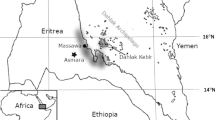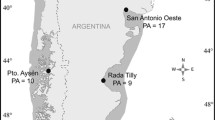Abstract
The taxonomic status of common dolphins (Delphinus sp.) remains controversial despite the increased number of studies focusing on its populations. Two species are presently recognized, Delphinus delphis and D. capensis. Apart from a phylogeographic study of the genus Delphinus, genetic studies focusing specifically in the northeast (NE) Atlantic remain scarce. Following ecological and morphological evidence for the existence of different common dolphin morphotypes in the Portuguese coast, we examined the population structure of D. delphis from the NE Atlantic by comparing DNA sequences from two mitochondrial regions (control region and cytochrome b gene). Additionally, we compared the sequences obtained with existing sequences of D. delphis from the Azores, Black Sea, Canary Islands, Pacific Ocean, D. capensis and also two closely related delphinid species (Stenella coeruleoalba and Tursiops truncatus). In the analysis of the NE Atlantic populations, we found evidence for the existence of some level of genetic differentiation. In the broader phylogenetic analysis, D. delphis and D. capensis did not show reciprocal monophyly and we found a group of highly divergent individuals. We discuss the possibility for the existence of two divergent lineages that have evolved independently, a separate subspecies or events of introgressive hybridization. These findings could have important implications on a taxonomic level, although further investigation based on a larger geographical scale and on nuclear loci information will certainly elucidate the origin of these highly divergent individuals.



Similar content being viewed by others
References
Adams LD, Rosel PE (2006) Population differentiation of the Atlantic spotted dolphin (Stenella frontalis) in the western North Atlantic, including the Gulf of Mexico. Mar Biol 148:671–681
Arnason U, Gretarsdottir S, Gullberg A (1993) Comparisons between the 12S rRNA, 16S rRNA, NADH1 and COI genes of sperm and fin whale mitochondrial DNA. Biochem Syst Ecol 21:115–122
Baird RW, Willis PM, Guenther TJ, Wilson PJ, White BN (1998) An intergeneric hybrid in the family Phocoenidae. Can J Zool Rev Can Zool 76:198–204
Baker RJ, Bradley RD (2006) Speciation in mammals and the genetic species concept. J Mammal 87:643–662
Baker CS, Medrano-Gonzalez L, Calambokidis J, Perry A, Pichler F, Rosenbaum H, Straley JM, Urban-Ramirez J, Yamaguchi M, Von Ziegesar O (1998) Population structure of nuclear and mitochondrial DNA variation among humpback whales in the North Pacific. Mol Ecol 7:695–707
Bandelt HJ, Forster P, Rohl A (1999) Median-joining networks for inferring intraspecific phylogenies. Mol Biol Evol 16:37–48
Bérubé M (2002) Hybridism. In: Perrin WF, Wursig B, Theweissen JGM (eds) Encyclopedia of marine mammals. Academic, San Diego, pp 596–600
Cassens I, Van Waerebeek K, Best PB, Tzika A, Van Helden AL, Crespo EA, Milinkovitch MC (2005) Evidence for male dispersal along the coasts but no migration in pelagic waters in dusky dolphins (Lagenorhynchus obscurus). Mol Ecol 14:107–121
Collet A (1981) Biologie du dauphin commun, Delphinus delphis L. en Atlantique Nord-Est. PhD Dissertation. U.E.R. des Sciences Fondamentales & Appliqués, Poitiers
Escorza-Trevino S, Dizon EA (2000) Phylogeography, intraspecific structure and sex-biased dispersal of Dall’s porpoise, Phocoenoides dalli, revealed by mitochondrial and microsatellite DNA analyses. Mol Ecol 9:1049–1060
Escorza-Trevino S, Archer FI, Rosales M, Lang AM, Dizon AE (2005) Genetic differentiation and intraspecific structure of Eastern Tropical Pacific spotted dolphins, Stenella attenuata, revealed by DNA analyses. Conserv Genet 6:587–600
Excoffier L, Smouse PE, Quattro JM (1992) Analysis of molecular variance inferred from metric distances among DNA haplotypes: application to human mitochondrial DNA restriction data. Genetics 131:479–491
Fu YX (1997) Statistical tests of neutrality of mutations against population growth, hitchhiking and background selection. Genetics 147:915–925
Gaubert P, Taylor PJ, Fernandes CA, Bruford MW, Veron G (2005) Patterns of cryptic hybridization revealed using an integrative approach: a case study on genets (Carnivora, Viverridae, Genetta spp.) from the southern African subregion. Biol J Linnean Soc 86:11–33
Heyning JE, Perrin WF (1994) Evidence for two species of common dolphins (Genus Delphinus) from the eastern north Pacific. Contr Sci Los Angeles 442:1–35
Holme S (1979) A simple sequentially rejective multiple test procedure. Scand J Statistics 5:65–79
Huelsenbeck JP, Ronquist F (2001) MRBAYES: Bayesian inference of phylogenetic trees. Bioinformatics 17:754–755
Jefferson TA, Van Waerebeek K (2002) The taxonomic status of the nominal dolphin species Delphinus tropicalis van bree, Mar Mamm Sci 118:787–818
Kingston SE, Rosel PE (2004) Genetic differentiation among recently diverged delphini taxa determined using AFLP markers. J Hered 95:1–10
LeDuc RG, Perrin WF, Dizon AE (1999) Phylogenetic relationships among the delphinid cetaceans based on full cytochrome b sequences. Mar Mamm Sci 15:619–648
Lopez A, Pierce GJ, Valeiras X, Santos MB, Guerra A (2004) Distribution patterns of small cetaceans in Galician waters. J Mar Biol Ass UK 84:283–294
Mallet J (2005) Hybridization as an invasion of the genorne. Trends Ecol Evol 20:229–237
Murphy S (2004) The biology and ecology of the short-beaked common dolphin Delphinus delphis in the North-east Atlantic. PhD Thesis, Department of Zoology, Ecology and Plant Science, Cork
Murphy S, Collet A, Rogan E (2005) Mating strategy in the male common dolphin (Delphinus delphis): What gonadal analysis tells us. J Mammal 86:1247–1258
Murphy S, Herman JS, Pierce GJ, Rogan E, Kitchener AC (2006) Taxonomic status and geographical cranial variation of common dolphins (Delphinus) in the eastern north Atlantic. Mar Mamm Sci 22:573–599
Natoli A, Cañadas A, Peddemors VM, Aguilar A, Vaquero C, Fernández-Piqueras P, Hoelzel AR (2006) Phylogeography and alpha taxonomy of the common dolphin (Delphinus sp.). J Evol Biol 19:943–954
Nei M (1987) Molecular evolutionary genetics. Columbia University Press, New York
O’Corry-Crowe GM, Suydam RS, Rosenberg A, Frost KJ, Dizon AE (1997) Phylogeography, population structure and dispersal patterns of the beluga whale Delphinapterus leucas in the western Nearctic revealed by mitochondrial DNA. Mol Ecol 6:955–970
Perrin WF, Armstrong WA, Baker AN, Barlow J, Benson SR, Collet AS, Cotton JM, Everhart DM, Farley TD, Mellon RM, Miller SK, Philbrick V, Quan JL, Rodriguez HRL (1995) An anomalously pigmented form of the short-beaked common dolphin (Delphinus delphis) from the Southwestern Pacific, Eastern Pacific, and Eastern Atlantic. Mar Mamm Sci 11:240–247
Posada D, Buckley T (2004) Model selection and model averaging in phylogenetics: advantages of Akaike information criterion and Bayesian approaches over likelihood ratio tests. Syst Biol 53:793–808
Posada D, Crandall KA (1998) MODELTEST: testing the model of DNA substitution. Bioinformatics 14:817–818
Reeves RR, Stewart BS, Clapham PJ, Powell JA (2002) Guide to marine mammals of the world. Alfred A. Knopf, New York
Reid JB, Evans PGH, Northridge S (2003) Atlas of cetaceans distribution in north-west European waters. Peterborough: Joint Nature Conservation Committee (JNCC)
Rokas A, Ladoukakis E, Zouros E (2003) Animal mitochondrial DNA recombination revisited. Trends Ecol Evol 18:411–417
Rosel PE (2003) PCR-based sex determination in Odontocete cetaceans. Conserv Genet 4:647–649
Rosel PE, Block BA (1996) Mitochondrial control region variability and global population structure in the swordfish, Xiphias gladius. Mar Biol 125:11–22
Rosel PE, Dizon AE, Heyning JE (1994) Genetic analysis of sympatric morphotypes of common dolphins (genus Delphinus). Mar Biol 119:159–168
Rosel PE, France SC, Wang JY, Kocher TD (1999) Genetic structure of harbour porpoise Phocoena phocoena populations in the northwest Atlantic based on mitochondrial and nuclear markers. Mol Ecol 8:S41–S54
Rozas J, Sanchez-DelBarrio JC, Messeguer X, Rozas R (2003) DnaSP, DNA polymorphism analyses by the coalescent and other methods. Bioinformatics 19:2496–2497**
Schneider S, Roessli D, Excoffier L (2000) Arlequin, ver.2.000: a software for population genetic data analysis. Genetics and Biometry Laboratory. University of Geneva, Switzerland
Silva MA (1999) Diet of common dolphins, Delphinus delphis, off the Portuguese continental coast. J Mar Biol Ass UK 79:531–540
Silva MA, Sequeira M (2003) Patterns in the mortality of common dolphins (Delphinus delphis) on the Portuguese coast, using stranding records, 1975–1998. Aquat Mamm 29:88–98
Sota T, Ishikawa R, Ujiie M, Kusumoto F, Vogler AP (2001) Extensive trans-species mitochondrial polymorphisms in the carabid beetles Carabus subgenus Ohomopterus caused by repeated introgressive hybridization. Mol Ecol 10:2833–2847
Stockin KA, Visser IN (2005) Anomalously pigmented common dolphins (Delphinus sp.) off northern New Zealand 31:43–51
Swofford DL (2003) PAUP*. Phylogenetic analysis using parsimony (*and other methods). Sinauer, Sunderland
Tajima F (1989) Statistical method for testing the neutral mutation hypothesis by DNA polymorphisms. Genetics 123:585–595
Tsaousis AD, Martin DP, Ladoukakis ED, Posada D, Zouros E (2005) Widespread recombination in published animal mtDNA sequences. Mol Biol Evol 22:925–933
Viricel A (2006) Spatial and social structure of the common dolphin Delphinus delphis in the Northeast Atlantic inferred from genetic data. Master’s thesis
Westgate AJ (2005) Population structure and life history of short-beaked common dolphins (Delphinus delphis) in the North Atlantic. PhD thesis
Witt JDS, Threloff DL, Hebert PDN (2006) DNA barcoding reveals extraordinary cryptic diversity in an amphipod genus: implications for desert spring conservation. Mol Ecol 15:3073–3082
Zhou JL, Salvador SM, Liu YP, Sequeira M (2001) Heavy metals in the tissues of common dolphins (Delphinus delphis) stranded on the Portuguese coast. Sci Total Environ 273:1–3
Zornetzer HR, Duffield DA (2003) Captive-born bottlenose dolphin × common dolphin (Tursiops truncatus × Delphinus capensis) intergeneric hybrids. Can J Zool 81:1755–1762
Acknowledgments
Tissue samples were kindly provided by Jennifer Learmonth (SAC—Scottish Agricultural College and DEFRA), Ángela Llavona (Coordinadora para o Estudio dos Mamíferos Mariños), Instituto para a Conservação da Natureza and Zoomarine. We would like to thank Georgina Budd for her linguistic revision of the manuscript and to two anonymous referees for their valuable comments, which have greatly improved the manuscript.
Author information
Authors and Affiliations
Corresponding author
Additional information
Communicated by S.A. Poulet.
Rights and permissions
About this article
Cite this article
Amaral, A.R., Sequeira, M., Martínez-Cedeira, J. et al. New insights on population genetic structure of Delphinus delphis from the northeast Atlantic and phylogenetic relationships within the genus inferred from two mitochondrial markers. Mar Biol 151, 1967–1976 (2007). https://doi.org/10.1007/s00227-007-0635-y
Received:
Accepted:
Published:
Issue Date:
DOI: https://doi.org/10.1007/s00227-007-0635-y




